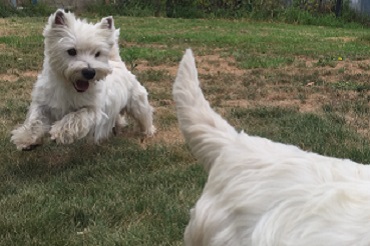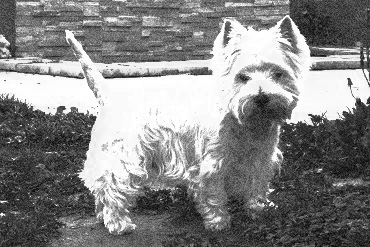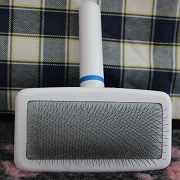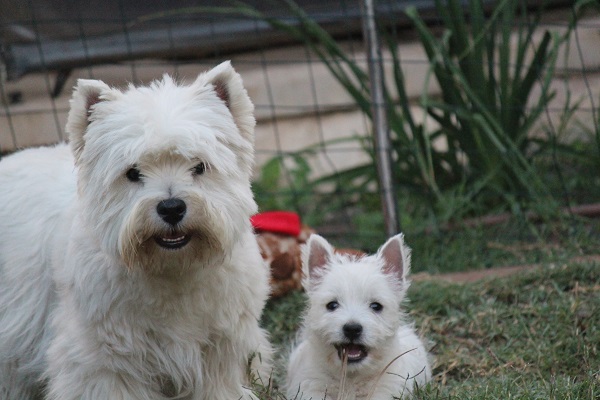
About Westies
Westies are a true terrier in every sense of the word. They are small but sturdy, bold and tough, yet very friendly.
They are loyal, affectionate, playful, enthusiastic little clowns. They love human company and are incredibly nosey - they want to be part of everything
that goes on in their homes and don't take too kindly to being excluded from anything. They bring an abundance of joy to our lives
with their cheeky little personalities, however, they can also be stubborn, loud, possessive, and bossy.
It will be up to you to determine if your Westie is a good companion or a whole lot of trouble.
It is important to set your ground rules right from the start.
If you let a puppy get away with things that it shouldn't be doing, just because they are cute,
then they will think that the behaviour is acceptable and if you change the rules later on, they will become confused.
If you don't want them to do something as an adult, don't teach them that it is ok as a pup. So when you catch your puppy
nibbling at your old pair of slippers and don't stop them, then don't complain when your adult Westie chews your
favourite pair of expensive shoes, because they won't see the difference.
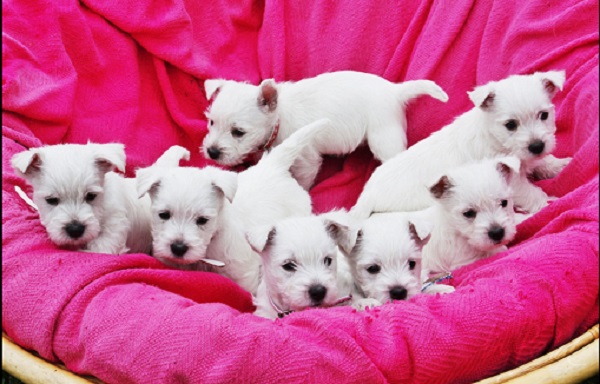
Westie History
The West Highland White Terrier originated at Poltalloch, Scotland, where they had been bred and maintained for more
than 100 years prior to their appearance at dog shows. In 1916, Colonel Malcolm of Poltalloch said that his father and
grandfather both kept them. It is probable that the lineage of the Malcolm dogs goes back to the time of King James I,
who asked for some "earth-doggies" out of Argyleshire. Years ago the breed was known as the Roseneath Terrier,
also as the Poltalloch Terrier.
As the legend goes, a reddish dog of his, emerging from cover, was mistakenly shot for a fox. Malcolm is said to have decided
on the spot to breed only for white dogs that could be readily identified in the field.
The first show held for the breed was at Crufts in London in 1907. Originally registered as the Roseneath Terrier,
the name was officially changed to West Highland White Terrier on May 31, 1909.
Westie Breed Standard
GENERAL APPEARANCE: Strongly built, deep in chest and back ribs; level back and powerful quarters on muscular legs and exhibiting in a marked degree a great combination of strength and activity.
CHARACTERISTICS: Small, active, game, hardy, possessed of no small amount of self-esteem with a varminty appearance.
TEMPERAMENT: Alert, gay, courageous, self reliant but friendly.
HEAD & SKULL: Skull slightly domed; when handled across forehead presents a smooth contour. Tapering very slightly from skull at level of ears to eyes. Distance from occiput to eyes slightly greater than length of foreface.
Head thickly coated with hair, and carried at right angle or less, to axis of neck. Head not to be carried in extended position. Foreface gradually tapering from eye to muzzle. Distinct stop formed by heavy, bony ridges immediately
above and slightly overhanging eye, and slight indentation between eyes. Foreface not dished nor falling away quickly below eyes, where it is well made up. Jaws strong and level. Nose black and fairly large, forming smooth contour with
rest of muzzle. Nose not projecting forward.
EYES: Set wide apart, medium in size, not full, as dark as possible. Slightly sunk in head, sharp and intelligent, which, looking from under heavy eyebrows, impart a piercing look. Light coloured eyes highly undesirable.
EARS: Small, erect and carried firmly, terminating in sharp point, set neither too wide nor too close. Hair short and smooth (velvety), should not be cut. Free from any fringe at top. Round-pointed, broad, large or thick ears or too heavily coated with hair most undesirable.
MOUTH: As broad between the canine teeth as is consistent with the varminty expression required. Teeth large for size of dog, with regular scissor bite, i.e. Upper teeth closely overlapping the lower teeth and set square to the jaws.
NECK: Sufficiently long to allow proper set on of head required, muscular and gradually thickening towards base allowing neck to merge into nicely sloping shoulders.
FOREQUARTERS: Shoulders sloping backwards. Shoulder blades broad and lying close to the chest wall. Shoulder joint placed forward, elbows well in, allowing foreleg to move freely, parallel to axis of body. Forelegs short and muscular, straight and thickly covered with short, hard hair.
BODY: Compact. Back level, loins broad and strong. Chest deep and ribs well arched in upper half presenting a flattish side appearance. Back ribs of considerable depth and distance from last rib to quarters as short as compatible with free movement of body.
HINDQUARTERS: Strong, muscular and wide across top. Legs short, muscular and sinewy. Thighs very muscular and not to wide apart. Hocks bent and well set in under body so as to be fairly close to each other when standing or moving.
Straight or weak hocks most under body so as to be fairly close to each other when standing or moving. Straight or weak hocks most undesirable.
FEET: Forefeet larger than hind, round, proportionate in size, strong, thickly padded. Under surface of pads and all nails preferably black.
TAIL: 13-15 cms (5-6 ins) long, covered with harsh hair, no feathering, as straight as possible, carried jauntily, not gay or carried over back. A long tail undesirable, and on no account should tails be docked.
GAIT/MOVEMENT: Free, straight and easy all round. In front legs freely extended forward from the shoulder. Hind movement free, strong and close. Stifle and hocks well flexed and hocks drawn under the body giving drive. Stiff, stilted movement behind and cow hocks highly undesirable.
COAT: Double coated. Outer coat consists of harsh hair, about 5 cms (2ins.) long free from any curl. Undercoat, which resembles fur, short, soft and close. Open coats most undesirable. Skin must appear healthy.
COLOUR: White
SIZE: Height: approx. 28 cms (11 ins) at withers
FAULTS: Any departure from the foregoing points should be considered a fault and the seriousness with which the fault should be regarded should be in exact proportion to its degree and its effect upon the health and welfare of the dog.
Bathing and Grooming Your Westie
Bath time
Before bathing your Westie, you should thoroughly brush them and then comb them to ensure that there are no mats. Make sure you have the right equipment.
Use a slicker brush which will remove their dead hair as you brush them and get a comb that has wide teeth at one end and tapers to narrow teeth at the other.
Westies can be strong willed and if they don't want you to brush them they will fight you all the way and this will make brushing them properly a difficult task.
If you try to brush a Westie that has not been brushed in weeks and is full of mats, brushing will be painful for them as the mats pull against their skin.
The key is to make it a pleasant experience for them. You want your Westie to want to be brushed. To do this you need to start off slowly. First get them to stand for you and then
lightly brush them. Avoid any areas that may have mats such as the legs and belly. If they act up, tell them 'No!' in a stern voice and then lightly brush an area that has no mats.
The initial aim is to let them know that you are going to brush them and that you are the boss. Once you can brush a small area without them acting up, tell them that they
are a good boy or good girl, and even give them a small treat. Slowly work up the size of the area that you are brushing and the length of time you have them standing for you.
If you can't brush out a particular mat, consider using scissors to cut it out. Try to slice the knot vertically, rather than cutting out big chunks of fur so that you don't make your Westie look
like they have just emerged from battle with a Dothraki horde.
In many cases the dog that you thought looked filthy and needed a bath will look much whiter, as much of the dirt that was on them will come off with brushing.
Ensure the shampoo you use is gently on their skin. Some pet stores will recommend oatmeal based shampoos for Westies, but many Westies are allergic to grains,
so these should be avoided. If you can't find a suitable shampoo at the per store, try Goats Milk shampoo available from most chemists and pharamacies.
Make sure you rinse all of the shampoo off your Westie and then dry them thoroughly.
If you are using a gentle shampoo, there is no reason why you can't bath them 2 or 3 times a month.
Grooming
Westies need to be groomed every 8 to 10 weeks. You can choose whether to have them clipped or hand-stripped.
Show dogs must be hand-stripped and this is a complex and time-consuming process where all of the dead hair is plucked by hand to thin
the coat out. Pet Westies do not need to be hand-stripped, if they are regularly brushed, they can be clipped every 8 to 10 weeks to maintain the classic Westie appearance.
Clipping is quicker, cheaper and less stressful for your Westie.
It is recommended that Westie puppies are hand-stripped at 16 weeks of age to remove their fine puppy hair and help their adult coat come through. This will make them easier to brush as
the puppy hair will easier break and mat if left in place.
Professional Groomers
If you are taking your Westie to a groomer, it doesn't mean that you don't have to brush your Westie. Whether they are being groomed by you or someone else, they still need to be brushed regularly (i.e. weekly).
When choosing a groomer, make sure they understand how a Westie should look. Many Westie owners return from inexperienced groomers disappointed because their Westie resembles a Maltese, a Scottish Terrier or are completely shaved.
If you see a nice looking Westie in your neighbourhood, say hello and ask the owner where they get their Westie groomed.
If you want to groom your Westie yourself, get hold of a grooming chart that shows how they should be groomed as you will need to know the correct length to cut the different sections of their coat.
Obedience training
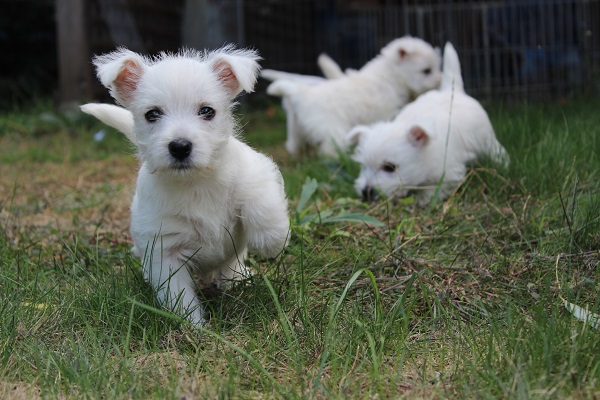
Westies are very intelligent and pick things up quickly. Like most new things, when you start to obediance train your Westie, start off slowly and build up the length and complexity of your training as you both progress.
Try the simple commands first, such as "sit", "wait" and "come". Learn one command at a time and don't introduce a new one until they have mastered the previous one.
Lead training can be a challenge. Start by practising in the yard before you go out in the street. Some Westies will take to it quite happily, but others will refuse to walk at all as soon as you attach a lead.
If they won't move with a lead on, don't pull or tug at the lead, especially with baby puppies. Try enticing them to walk by dangling a treat in front of them. If they take two or three steps let them have the treat and praise them.
Next time make them take 5 or 6 steps before they get the treat and build up from there. The other option is to drop the lead and walk away. After a while they will decide to follow you. Let them keep walking around and getting used to the weight of the lead being there.
Eventually you can pick up the lead and hopefully they will continue to walk along with you.
One important tip when training any dog is do not repeat a command if the dog does not obey. For example if you tell your dog to "sit" and they don't sit, don't keep saying "sit", "sit", "sit, SIT!" and then praise them when they finally sit.
This teaches your Westie they don't have to sit until after the fifth time you say the command. Say it once and if they do not sit, then walk over and push their butt down. You must enforce your commands to retain your alpha status.
Another important tip is that when you Westie is acting up, do not say "be a good boy" or "be a good girl". Their selective hearing will kick in and they will only hear "good boy" or "good girl" which provides a negative reinforcement.
When they are misbehaving tell them "NO" or "STOP" in a stern voice. Do not give them any attention until they are behaving in the way you want them to behave.
Remember that Westies can be stubborn, which means if they don't want to do something, then they won't do it. They key is making them want to do it.
This means making training fun. Give lots of rewards when you Westie does what you want it to do. Rewards do not have to be food treats. Westies enjoy praise and attention, so use these as training tools.
The other Westie trait that you can take advantage of is FOMO (fear of missing out). Westies like to be part of everything, so use that to your advantage. For example if your Westie won't come to you,
run away in the opposite direction. Your Westie will be confused at first but then they will think you might be going somewhere interesting and exciting and decide to join you. When you see them coming towards you stop
and as they approach use the command "come" and then give them lost of praise and attention when they get to you.

